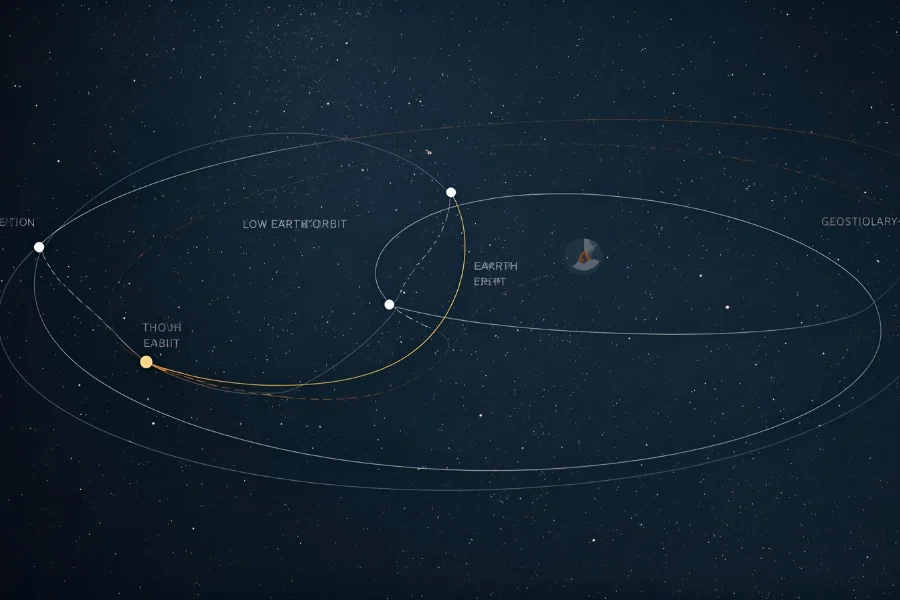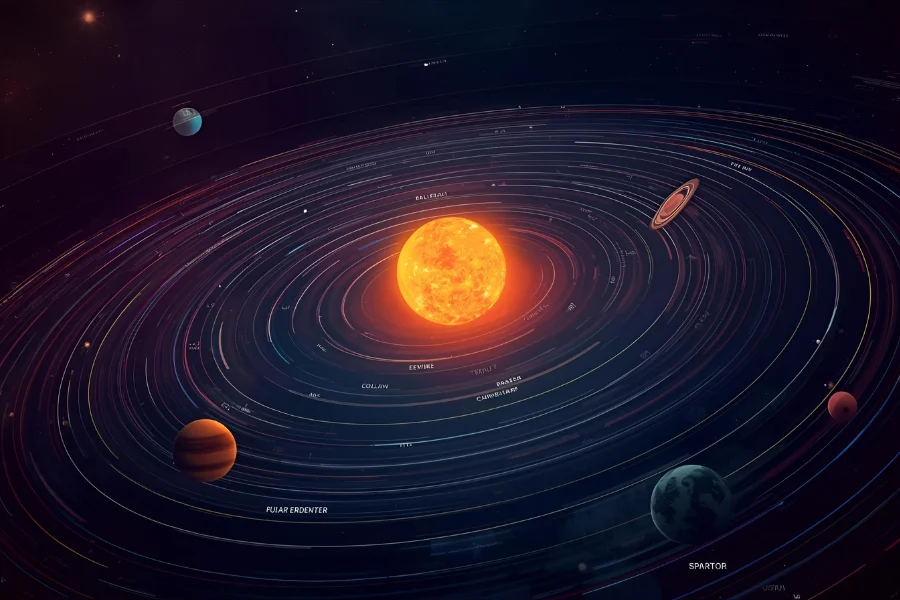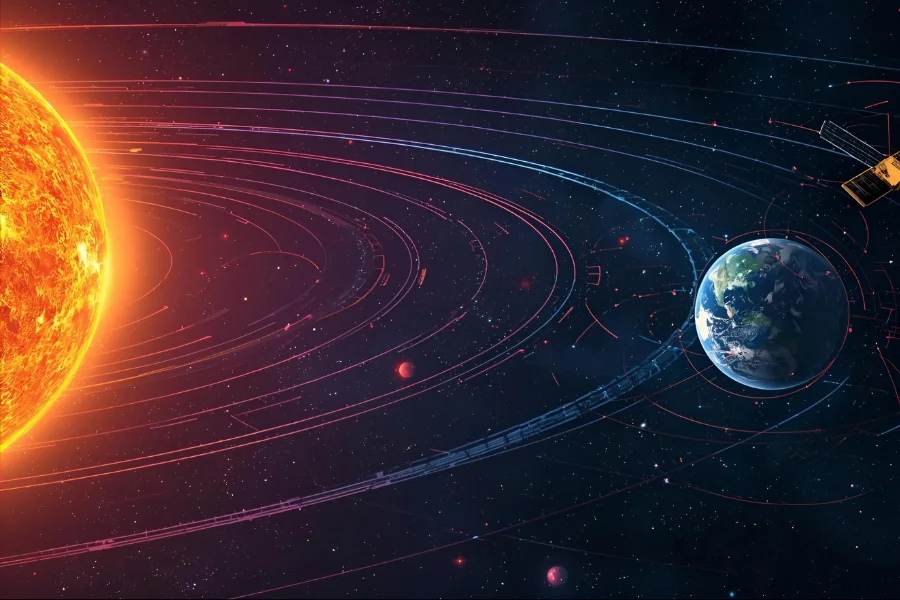Word Orbit: Meaning, Origin & Everyday Uses
The word orbit is one you hear a lot. You hear it when talking about Earth’s orbit around the Sun or a satellite moving in space. It is not just a science word. In life, we say someone is in your orbit. It means they are close to you or important in your world.
The meaning of orbit is simple. It is a path that goes around something. The word comes from Latin and means a track or path. You can think of it like a circle that keeps going. The Moon orbits Earth, moving in a steady circular path. Your day can move in its own orbit too. You might go around your work, family, or hobbies.
In science, an orbit is the gravitational path that keeps planets and moons moving. Gravity pulls objects in. Speed keeps them from falling. If a planet moves too slowly, it falls toward the Sun. If it moves too fast, it flies away. Every type of orbit shows balance in nature.
We use the word orbit in daily life too. You can say your world orbits around your kids or your dreams. It shows how things we care about guide our life.
Latin Roots and Early Meanings of the Word Orbit
The word orbit comes from the Latin word orbita, which means track or wheel path. Long ago, it described the circular paths of wheels. Romans also used it to explain how the sky moves. They compared the stars to chariots on a track.
Knowing this helps you see why orbit became important in science and language. It didn’t only mean planets. It also meant any repeating path. Think of your daily walk. That is your own orbit.
How the Word Orbit Evolved From Astronomy to Anatomy?
By the Middle Ages, orbit also described the eye socket. The cavity is round and protective, like a planet’s path around the sun. This shows how words move from one field to another.
Today, doctors, astronomers, and teachers all use orbit in different ways. It helps people connect ideas to real life.
Modern Adaptations and Metaphorical Uses
Now, orbit is used beyond science. People use it to mean influence or routines. For example, saying someone is in the “orbit of a mentor” means guidance surrounds them.
Technology also uses it. Satellites in orbit run GPS, communication, and weather tracking. In business, orbiting ideas revolve around a main point.
Types of the Word Orbit Explained

Low Earth Orbit (LEO) Closest to Earth
Low Earth Orbit or LEO is the closest orbit to Earth. It sits 160 to 2,000 kilometers above us. Satellites here move fast and circle the planet in about 90 minutes. That’s why the ISS looks like it’s flying across the sky.
LEO is great for watching Earth, checking weather, and sending data quickly. Signals travel fast and images are clear. Many companies use LEO because it’s cheaper and easier to reach. Small satellite groups can even give almost real-time coverage.
Medium Earth Orbit MEO The Middle Zone
Medium Earth Orbit or MEO is between LEO and GEO. It sits 2,000 to 35,000 kilometers above Earth. Satellites here move slower than LEO but cover more ground. Most GPS satellites use MEO to help your devices navigate anywhere.
MEO gives a good balance of speed, coverage, and cost. You don’t need many satellites to cover large areas. Many MEO satellites work in groups called constellations to provide constant signals.
Tip: MEO is great for reliable navigation and communication.
Geostationary Orbit GEO Staying in One Spot
Geostationary Orbit or GEO is about 35,786 kilometers above Earth. Satellites here move with Earth, so they stay over the same spot. That makes them great for weather, TV, and steady communication.
They cover large areas, but signals take a bit longer to reach us. GEO is perfect if you want constant coverage, like tracking storms or managing networks. These satellites stay in place and work reliably.
Elliptical vs Circular Orbits Different Shapes Different Speeds
Orbits aren’t always circles. In circular orbits, satellites stay the same distance from Earth. Elliptical orbits change distance, so satellites speed up when they’re close and slow down when they’re far. It’s like a racetrack circular moves steady, elliptical speeds up on the curves.
Elliptical orbits work well for areas at high latitudes. Circular orbits in LEO and GEO offer steady coverage. One thing to remember is that circular orbits are usually easier to handle. Elliptical orbits can help reach spots that circular ones can’t.
Natural vs Artificial Orbits Planets vs Satellites
Natural orbits are paths of planets, moons, and asteroids. Artificial orbits are made by humans, like satellites and space stations. Both follow physics, but humans carefully control artificial orbits.
This explains why satellites stay in place while planets move freely.
Tip: Artificial orbits are planned to avoid collisions and work efficiently. This keeps communication, navigation, and observation reliable.
| Orbit | Altitude | Use | Satellites |
|---|---|---|---|
| LEO | 160–2,000 km | Observation, ISS | Earth observation, ISS |
| MEO | 2,000–35,000 km | Navigation, Comm | GPS, comm constellations |
| GEO | 35,786 km | Weather, TV, Comm | Weather, TV, comm satellites |
| Elliptical | Variable | High-latitude, Coverage | Molniya, recon satellites |
Real-World Examples:
- Your GPS relies on MEO satellites to guide your phone or car.
- Weather satellites in GEO track hurricanes in real time to help warn millions.
- The ISS in LEO circles Earth every 90 minutes, letting astronauts conduct experiments.
- Molniya satellites in elliptical orbits provide coverage to high-latitude areas like Russia.
Everyday and Technological Uses of the Word Orbit
You probably use the word orbit without realizing it. It’s not just about space. When you say a friend is “in your orbit,” you mean they’re close to you. This idea is also in the tech you use every day. Your phone’s GPS needs satellites in orbit. Your weather app uses them too. Even satellite TV comes from a spacecraft circling Earth. It’s amazing how this one idea connects friends, phones, and forecasts. Orbits are part of your daily life.
Orbits in Satellites and Space Missions
Satellites need the right orbit to stay in place. The International Space Station (ISS) circles Earth within Low Earth Orbit (LEO). This helps it circle Earth fast and lets astronauts work safely. Without the right orbit, satellites can drift or lose connection.
Different orbits have different jobs. Geostationary Orbit (GEO) keeps satellites over the same spot. This gives constant TV and internet signals. Medium Earth Orbit (MEO) holds GPS satellites. They guide your phone or car accurately. Scientists choose orbits based on mission and coverage needs.
Orbits also guide space missions. They save fuel and keep spacecraft safe. Even small mistakes can affect the mission. NASA and ESA calculate orbits carefully for trips to the Moon, Mars, or beyond.
The Orbits of Earth, the Moon, and Other Planets

Everything in space follows a path. Our Earth circles the sun every year. This gives us our seasons. The moon orbits us every month. That’s why we see moon phases. Other planets follow their own paths too. These orbits keep our solar system balanced. They stop planets from crashing. Scientists use this knowledge every day. They predict tides and plan space missions. They even design our calendars. Our whole sense of time comes from these cosmic paths.
How Orbits Power Communication, GPS, and Weather Systems
Your daily tech relies on satellites in space. Some satellites provide your TV and internet. Others help your phone’s GPS find locations. Weather satellites track storms from above. Engineers place each satellite in a perfect path. This keeps our systems working smoothly. Without these precise orbits, your navigation would fail. Your weather app would not know the forecast. Even your simplest phone app needs these faraway satellites. Modern life depends on objects circling our planet.
The Word Orbit in Human Anatomy

The Meaning of Orbit in Medicine and the Human Body
In medicine, the orbit is the bone pocket that holds your eye. It acts like a natural helmet. This socket keeps your eye safe. It also lets your eye move around. This area is full of muscles and nerves. They help you see. If your orbit gets hurt, it can cause problems. You might feel pain or see double. Your eye might even look different. Doctors check this area with special scans. Knowing about your orbit helps you protect your sight. Your orbit is your eye’s protective home. It keeps your vision safe and sound.
Bones That Form the Eye Orbit (Eye Socket)
Your eye socket is made of seven bones. They fit together like a puzzle. These bones include your cheekbone and forehead bone. They form a strong, protective cup. This cup holds your eye safely in place. It shields your eye from harm. Doctors study this bone structure. It helps them fix injuries or do surgery. Knowing about it keeps your eyes safe. Your eye socket is a bony shield. It keeps your vision secure.
Common Medical Conditions Related to the Orbit
Several conditions can affect your eye socket. Here are the most common ones.
- A broken socket bone from a hit or fall
- A bad infection behind your eye
- Thyroid problems that make eyes bulge
Watch for eye pain, swelling, or double vision. Your eye might look different too. See a doctor right away if this happens. They can do a scan to find the problem. Quick treatment helps save your vision.
Modern Meaning of the Word Orbit in Culture

What “Orbiting” Means in Social Media and Dating
So, orbiting is like, you’re still kinda linked up with someone online, but not, like, actually talking. You might see what they post or watch their stories, but no calls or texts. It happens a lot when dating or on social media and someone wants to stay in your world, but not, you know, in it.
It can be weird.You see their online activity but don’t hear anything directly. It’s like they’re just circling you. If it gets to you, maybe mute their posts or just step away for a bit. This helps clear your head and chill you out.
The Psychology Behind Orbiting Someone Online
Orbiting often comes from curiosity or unresolved feelings. People stay connected this way to avoid rejection while still feeling close. It can create a cycle of attention and anxiety for both people.
This can affect your mood and confidence. Knowing why someone orbits you helps you set boundaries. You can also focus on your own life instead of watching every online move.
Other Modern Expressions Related to the Word Orbit
The word orbit now means more than space. It describes attention, influence, or social closeness. “In your orbit” means someone is part of your circle. “Out of orbit” means someone is disconnected or irrelevant.
These phrases help explain relationships and online behavior. Knowing them can improve how you communicate and read social cues.
Summary
The word orbit shows up everywhere. It means a path around something. In space, planets, moons, and satellites follow orbits. In life, it can mean people or routines that revolve around you. Spotting these paths helps you understand nature, tech, and relationships.
In technology, satellites need precise orbits. LEO satellites watch Earth and weather. MEO satellites guide GPS for phones and cars. GEO satellites give TV, internet, and weather updates. Elliptical orbits reach tricky areas. These orbits keep our tech running smoothly.
In medicine, the orbit is your eye socket. It’s a protective home for your eye. It holds muscles, nerves, and blood vessels. Damage here can affect sight. Knowing this helps you care for your eyes.
Culturally, orbit is also a metaphor. “In your orbit” means someone is close or important to you. On social media, orbiting is quietly following without talking.
FAQs
What does the word orbit mean?
An orbit is a path that circles around something.
What is an orbit in science?
It’s the curved path planets, moons, or satellites follow under gravity.
Why is it called orbit?
It comes from Latin orbita, meaning track or wheel path.
What is the most common orbit?
Low Earth Orbit (LEO) is the closest and most used orbit.
Which three primary types of orbits do satellites and celestial bodies follow?
LEO, MEO, and GEO are key satellite orbits.
What is a full orbit?
One complete trip around the object being orbited.
What is the verb form of orbit?
To orbit means to move in a path around something.
What is a synonym for orbit?
Path, track, course, circuit, revolution.
What is a synonym for orbiting?
Circling, revolving, rotating, going around.
What words are associated with orbit?
Gravity, satellite, planet, moon, rotation.
What is the orbit in the human body?
It’s the eye socket, holding muscles, nerves, and the eyeball.
What bones form the eye orbit?
Seven bones including the cheekbone and forehead bone.
What is the strongest part of the orbit?
The bony rim protects the eye from impact.
Can damage to the orbit affect vision?
Yes, injuries or infections can cause double vision or pain.
How do satellites achieve orbit?
By reaching the right speed and altitude so gravity keeps them moving.
Can humans go past low Earth orbit?
Yes, astronauts travel to higher orbits for space missions.
What is the difference between natural and artificial orbits?
Natural orbits are planets or moons; artificial orbits are satellites.
How do satellites use LEO, MEO, and GEO?
LEO observes Earth, MEO powers GPS, GEO maintains TV and weather satellites.
What does being in someone’s orbit mean?
It means you are close or influential in their life.
What is orbiting in social media?
Watching or following someone online without direct interaction.
What does orbit mean in love or dating?
Someone orbiting you shows interest but avoids direct contact.
Why do people orbit you online?
Curiosity, unresolved feelings, or staying connected without commitment.
What are the four main types of space orbits?
LEO, MEO, GEO, and elliptical orbit.
What is low Earth orbit (LEO)?
The closest orbit to Earth, ideal for observation and the ISS.
What is medium Earth orbit (MEO)?
Middle orbit for GPS and communication satellites.
What is geostationary orbit (GEO)?
High orbit that stays above the same spot on Earth.
What is an elliptical orbit?
An oval-shaped orbit that changes distance and speed.
How do Molniya satellites work?
They use elliptical orbits to cover high-latitude areas like Russia.
